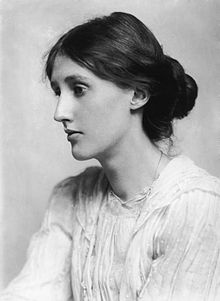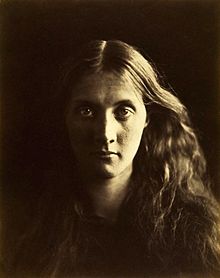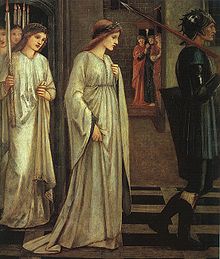Virginia Woolf
This article is about the British modernist author. For the American children's author, see Virginia Euwer Wolff. For the British rock band, see Virginia Wolf.
Virginia Woolf

Virginia Woolf at 20
| Born | Adeline Virginia Stephen 25 January 1882 Kensington, Middlesex, England |
| Died | 28 March 1941 (aged 59) River Ouse, near Lewes, Sussex, England |
| Occupation | Novelist, essayist, publisher, critic |
| Nationality | British |
| Alma mater | King's College London |
| Notable work(s) | |
| Spouse(s) | Leonard Woolf |
| Signature |  |
Contents
Adeline Virginia Woolf (/ˈwʊlf/; née Stephen; 25 January 1882 – 28 March 1941) was an English writer, and one of the foremost modernists of the twentieth century.
During the interwar period, Woolf was a significant figure in London literary society and a central figure in the influential Bloomsbury Group of intellectuals. Her most famous works include the novels Mrs Dalloway (1925), To the Lighthouse (1927) and Orlando (1928), and the book-length essay A Room of One's Own (1929), with its famous dictum, "A woman must have money and a room of her own if she is to write fiction." Woolf suffered from severe bouts of mental illness throughout her life, thought to have been the result of what is now termed bipolar disorder,1 and committed suicide by drowning in 1941 at the age of 59.
Early Life
Virginia Woolf was born Adeline Virginia Stephen at 22 Hyde Park Gate in London.2 Her parents were Sir Leslie Stephen (1832–1904) and Julia Prinsep Duckworth Stephen (née Jackson) (1846–1895).2 Leslie Stephen was a notable historian, author, critic and mountaineer.3 He was a founding editor of the Dictionary of National Biography, a work which would influence Woolf's later experimental biographies. Julia Stephen was a renowned beauty, born in British India to Dr. John and Maria Pattle Jackson. She was also the niece of the photographer Julia Margaret Cameron and first cousin of the temperance leader Lady Henry Somerset. Julia moved to England with her mother, where she served as a model for Pre-Raphaelite painters such as Edward Burne-Jones.4

Photographic portrait of Woolf's mother, Julia Stephen, taken by Julia Margaret Cameron, Julia's aunt
Woolf was educated by her parents in their literate and well-connected household at 22 Hyde Park Gate, Kensington. Her parents had each been married previously and been widowed, and, consequently, the household contained the children of three marriages. Julia had three children by her first husband, Herbert Duckworth: George, Stella, and Gerald Duckworth. Leslie first married Harriet Marian (Minny) Thackeray (1840–1875), the daughter of William Thackeray, and they had one daughter: Laura Makepeace Stephen, who was declared mentally disabled and lived with the family until she was institutionalised in 1891.5 Leslie and Julia had four children together: Vanessa Stephen (1879), Thoby Stephen (1880), Virginia (1882), and Adrian Stephen (1883).
Sir Leslie Stephen's eminence as an editor, critic, and biographer, and his connection to William Thackeray, meant that his children were raised in an environment filled with the influences of Victorian literary society. Henry James, George Henry Lewes, and Virginia's honorary godfather, James Russell Lowell, were among the visitors to the house. Julia Stephen was equally well connected. She came from a family of beauties who left their mark on Victorian society as models for Pre-Raphaelite artists and early photographers, including her aunt Julia Margaret Cameron who was also a visitor to the Stephen household. Supplementing these influences was the immense library at the Stephens' house, from which Virginia and Vanessa were taught the classics and English literature. Unlike the girls, their brothers Adrian and Julian (Thoby) were formally educated and sent to Cambridge, a difference that Virginia would resent. The sisters did, however, benefit indirectly from their brothers' Cambridge contacts, as the boys brought their new intellectual friends home to the Stephens' drawing room.citation needed

Julia Prinsep Stephen portrayed by Edward Burne-Jones, 1866
According to Woolf's memoirs, her most vivid childhood memories were not of London but of St. Ives in Cornwall, where the family spent every summer until 1895. The Stephens' summer home, Talland House, looked out over Porthminster Bay, and is still standing today, though somewhat altered. Memories of these family holidays and impressions of the landscape, especially the Godrevy Lighthouse, informed the fiction Woolf wrote in later years, most notably To the Lighthouse.
The sudden death of her mother in 1895, when Virginia was 13, and that of her half-sister Stella two years later, led to the first of Virginia's several nervous breakdowns. She was, however, able to take courses of study (some at degree level) in Greek, Latin, German and history at the Ladies' Department of King's College London between 1897 and 1901, and this brought her into contact with some of the early reformers of women's higher education such as Clara Pater, George Warr and Lilian Faithfull (Principal of the King's Ladies' Department and noted as one of the Steamboat ladies).6 Her sister Vanessa also studied Latin, Italian, art and architecture at King's Ladies' Department. On 2 May 2013, it was announced that Woolf was to be honoured by her alma mater when, in Autumn 2013, the Virginia Woolf Building of King's College London would open on Kingsway, London.7
The death of her father in 1904 provoked her most alarming collapse and she was briefly institutionalised.5 Modern scholars (including her nephew and biographer, Quentin Bell) have suggested8 her breakdowns and subsequent recurring depressive periods were also influenced by the sexual abuse to which she and her sister Vanessa were subjected by their half-brothers George and Gerald Duckworth (which Woolf recalls in her autobiographical essays A Sketch of the Past and 22 Hyde Park Gate).
Throughout her life, Woolf was plagued by periodic mood swings and associated illnesses. She spent three short periods in 1910, 1912 and 1913 at Burley House, 15 Cambridge Park, Twickenham, described as "a private nursing home for women with nervous disorder".9 Though this instability often affected her social life, her literary productivity continued with few breaks throughout her life.